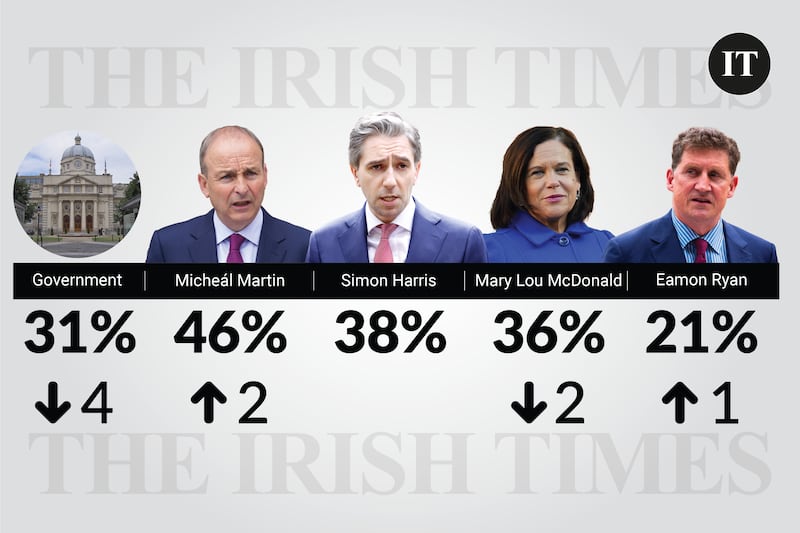The tide may be turning for the Government. An apparently unassailable lead for Sinn Féin only nine months ago has since evaporated, according to the latest Irish Times/Ipsos B&A poll.
Support for Sinn Féin is down to 23 per cent, a drop of five points and its lowest rating since before the 2020 general election. Fine Gael are now neck and neck with Sinn Féin, up four points to 23 per cent.
There is no movement for Fianna Fáil, who remain on 20 per cent.
Only marginal changes are registered for Labour (up one point to 5 per cent) and the Green Party (down one point to 4 per cent).
The Social Democrats are polling at 3 per cent (down one), People Before Profit/Solidarity at 2 per cent (unchanged) and Aontú at 1 per cent (unchanged).
The proportion of the electorate expecting to vote Independent at the next general election, at 17 per cent, is also unchanged.
Today’s poll was conducted among a national sample of 1,500 voters on Monday and Tuesday of this week. A larger sample size than usual – normally 1,200 voters – was necessary to facilitate a subsample of 500 in each of the three European Parliament constituencies. All interviews were conducted in homes by Ipsos B&A interviewers.
Timing is everything, and the peak for Sinn Féin now looks to have been in July 2022 when the party reached 36 per cent support. It has, however, taken until this year for support to wane, dropping initially to 28 per cent in February and then further to 23 per cent in May.
Falling in tandem with support for her party has been Mary Lou McDonald’s satisfaction rating, down to 36 per cent. The Sinn Féin leader registered her highest rating – of 49 per cent – in June 2020, just after the general election.
Losses for Sinn Féin can be seen across all demographics, with declines since February sharper among some groups, most notably among the under-35s (down 10 points to 29 per cent per cent) and in the Rest of Leinster region, excluding Dublin (down 10 points to 24 per cent).
It is impossible to know exactly what is behind the Sinn Féin retreat, but Snapshot polls by Ipsos B&A for The Irish Times show housing and immigration to be the two hot topics of conversation among the Irish public since the start of the year. How well Sinn Féin is performing on these issues is likely to have had a bearing, as is also how strongly the Government parties and the new Taoiseach have responded to these challenges.
Today’s poll is the first measure of support for Fine Gael since Leo Varadkar stepped down and Simon Harris stepped up. A gain of four points for Fine Gael is a good start for the new leader.
It is too soon to get a full read on how Harris is viewed by the public, with one in three voters (33 per cent) not yet able to offer an opinion. Where an opinion is expressed, it is more likely to be positive (38 per cent) than negative (30 per cent).
When voters were asked what they expect from the new leader of Fine Gael the majority appear at least open-minded, either believing that Harris would bring the party in a new direction (20 per cent) or waiting to hear what he has to say (38 per cent). One in three (36 per cent) are expecting more of the same, which could be a good or a bad thing, depending on what you think of Fine Gael to begin with.

The most popular party leader in Ireland today is Fianna Fáil’s Micheál Martin with 46 per cent of voters satisfied with his performance, up two points since February.
Curiously Fianna Fáil still trail Sinn Féin in party support (20 per cent versus 23 per cent) despite having a leader who is significantly more popular.
Within some demographics Fianna Fáil is ahead of the pack, including among the over-65s (31 per cent support) and in Munster (27 per cent support).
For the time being party politics in Ireland is a three-horse race. For voters eschewing the main parties the preferred option is likely to be an Independent candidate – the choice of 17 per cent – as opposed to one of the smaller parties.
Every electorate has a floating cohort so the past few years in Irish politics have been somewhat unusual in that voting preferences have been remarkably stable. Today’s poll findings suggest a degree of instability has returned.
In the past couple of years none of the smaller parties has broken through the 5 per cent ceiling. With voters on the move again perhaps one of these parties will catch a wave.
It all makes for a very interesting year ahead.
Damian Loscher is President of Ipsos B&A
- Listen to our Inside Politics Podcast for the latest analysis and chat
- Sign up for push alerts and have the best news, analysis and comment delivered directly to your phone
- Find The Irish Times on WhatsApp and stay up to date




